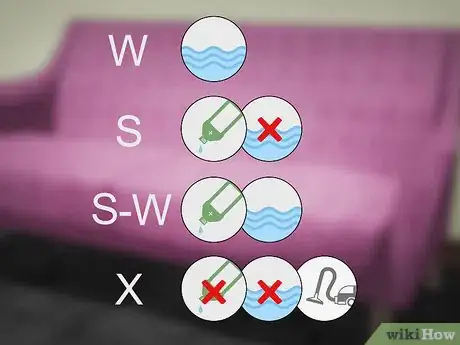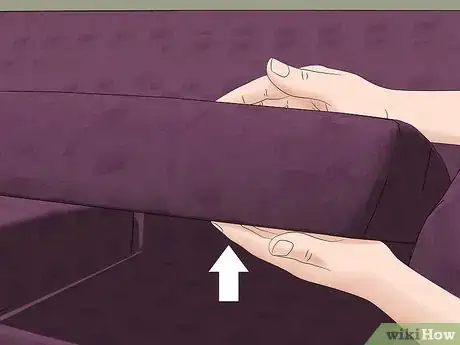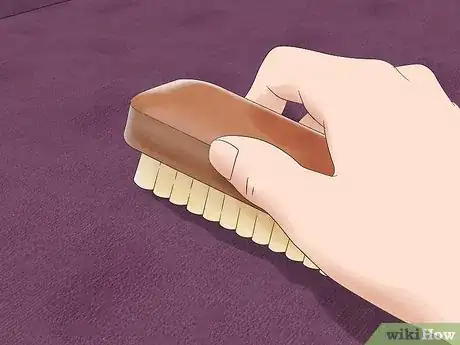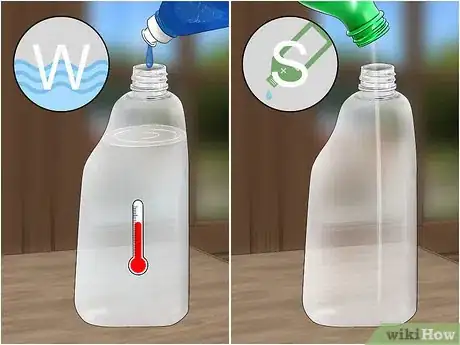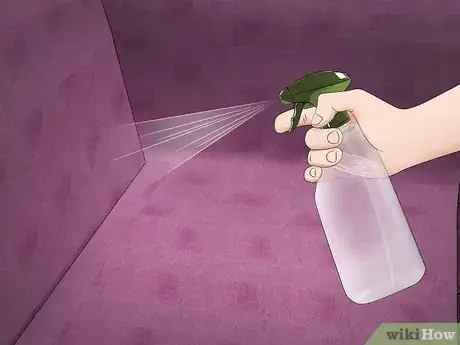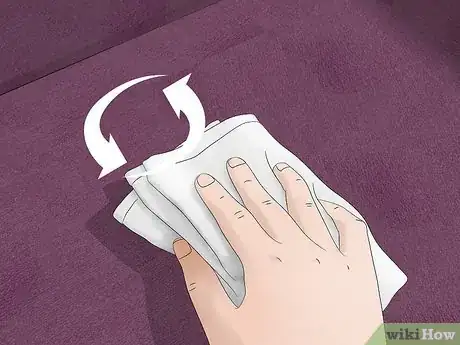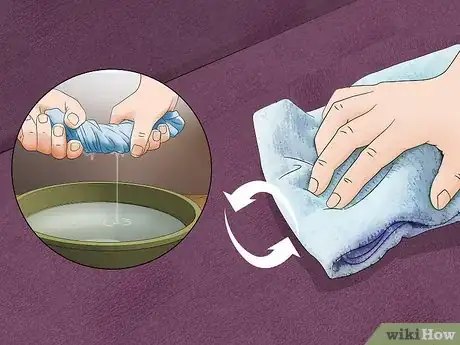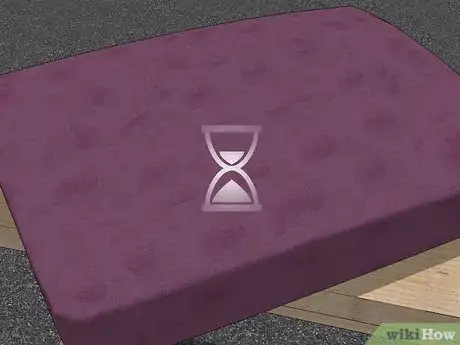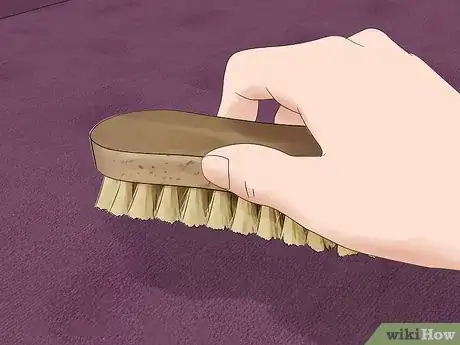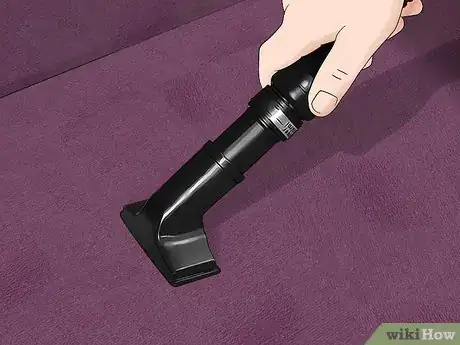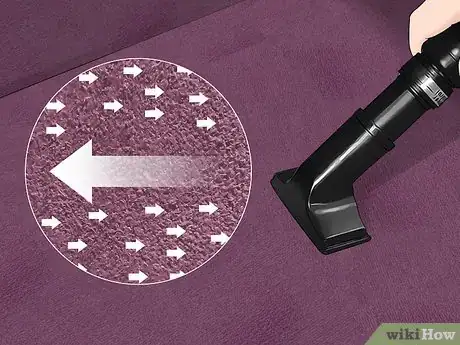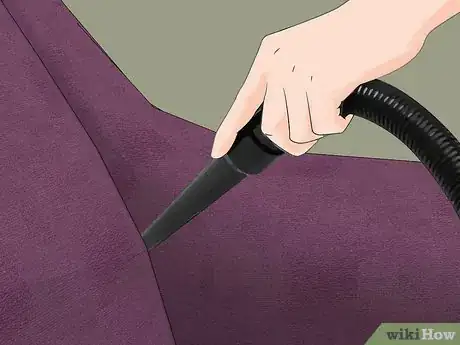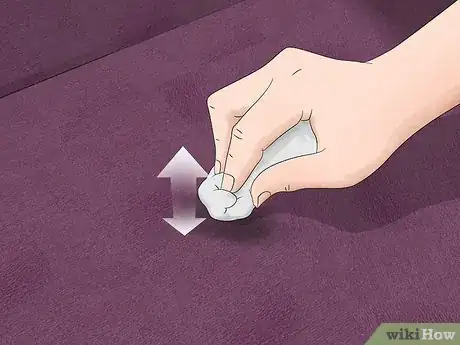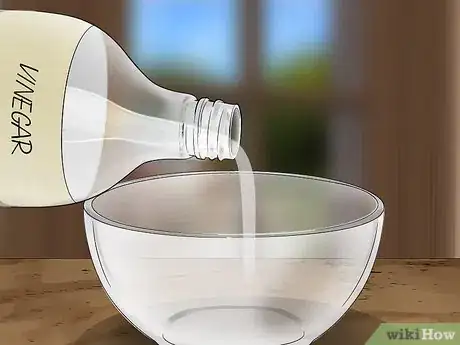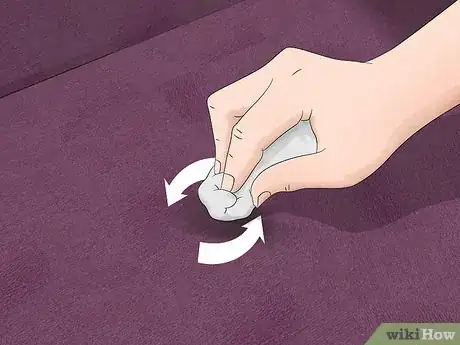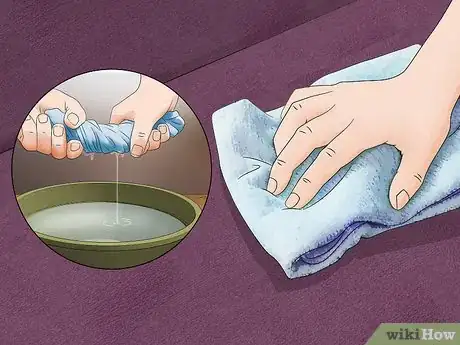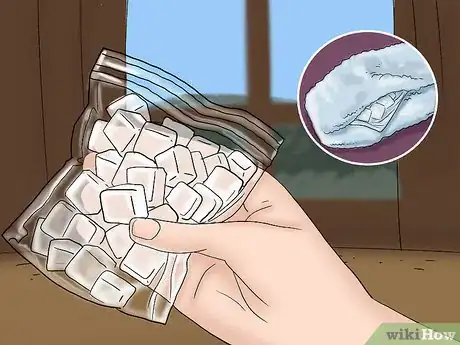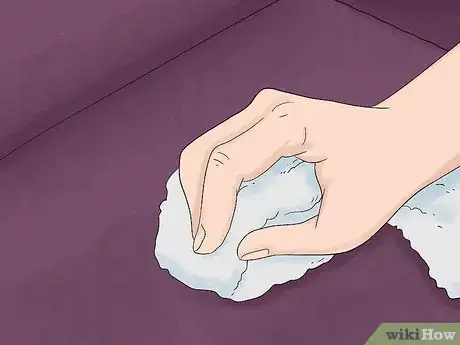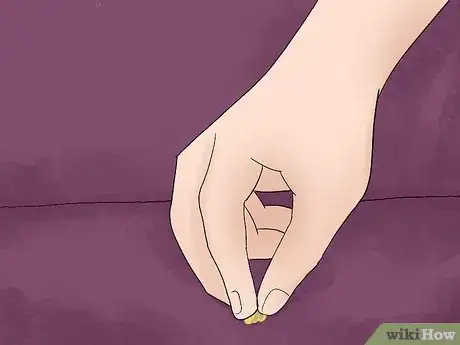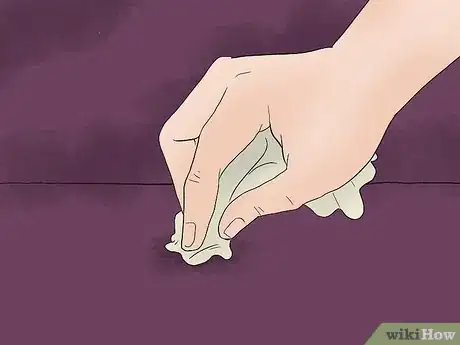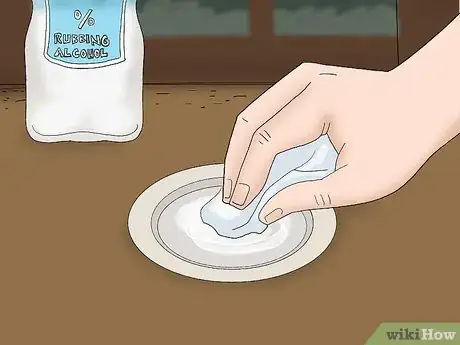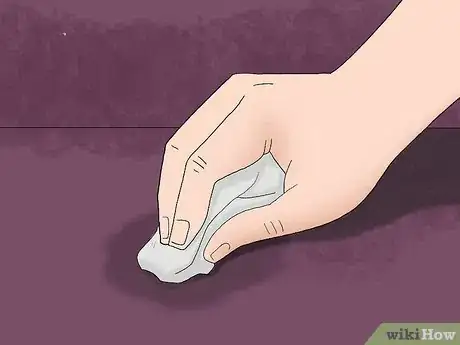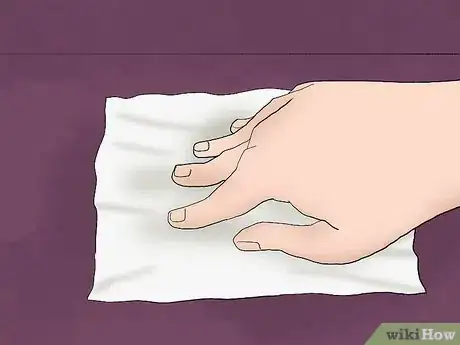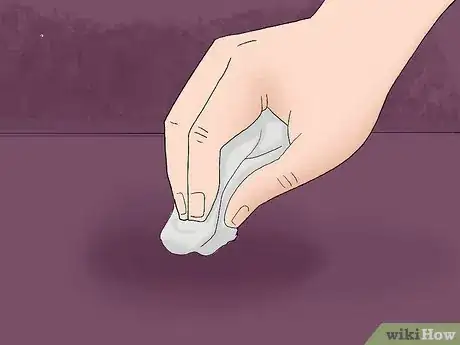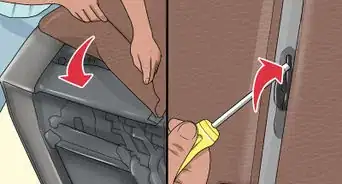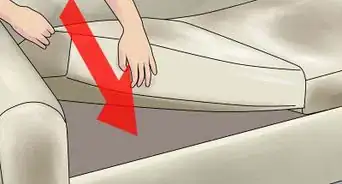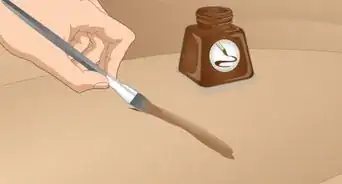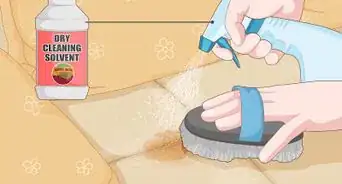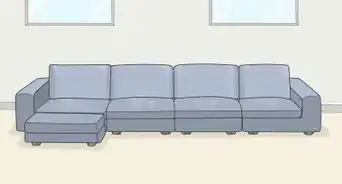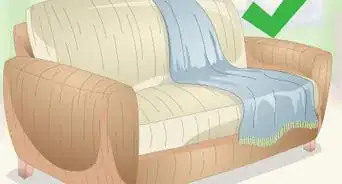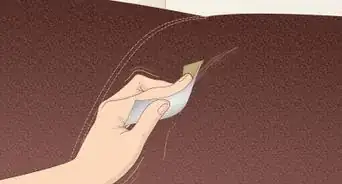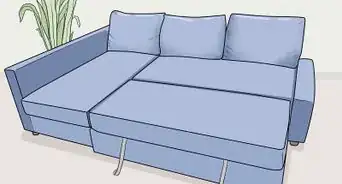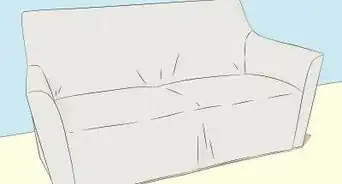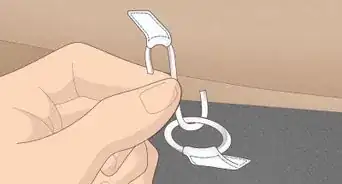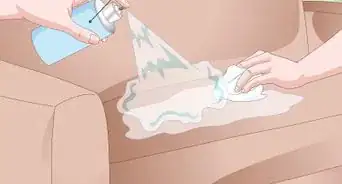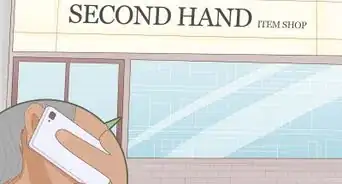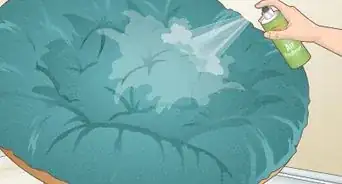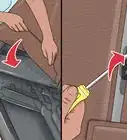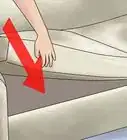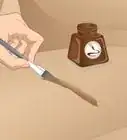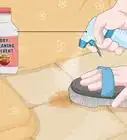This article was co-authored by Michelle Driscoll, MPH. Michelle Driscoll is the Owner of Mulberry Maids, which is based in Fort Collins, Colorado. With five years of experience, her business specializes in cleaning homes and small offices. She holds a Masters in Public Health from the Colorado School of Public Health. Additionally, Mulberry Maids has an A+ rating from the Better Business Bureau.
This article has been viewed 20,801 times.
Suede is a very popular material for furniture, particularly because it’s so durable. However, like any couch, your suede couch can get dirty from use. Check the care label to make sure you’re using the appropriate cleaners for your suede. Vacuum suede that can’t handle water, and use white vinegar to target specific stains.
Steps
Doing General Cleaning
-
1Check the care tag. Your suede couch should have a care label that tells you how to clean it. A W-label indicates that it’s safe to use water when cleaning your couch. An S-label couch will react well to solvents like rubbing alcohol, but you should avoid using water. A S-W label means you can use either water or a special solvent, but a X-label means you can’t use any liquid at all. For X-label couches, you should only use your vacuum for cleaning the couch cushions.[1]
- If you can’t find a care tag on your couch, a safe way to proceed is to treat it as if it has an S-tag.
-
2Remove your couch cushions. If you can, remove the cushions from your suede couch. This will allow you to clean both sides and make it easier to get the entire cushion clean. If your cushions are not removable, be extra careful to clean the whole cushion.Advertisement
-
3Use a suede brush to work up the nap. Working against the grain of the suede in your cushion, gently brush the cushion with a suede brush. This lifts up the nap, which helps you saturate the cushion with cleaner.
- If you don’t have a suede brush, a clean bath towel will work just as well.
-
4Mix the proper cleaning solution. For couches with W-labels, fill a spray bottle with warm water and then add a few squirts of mild dish soap. If your couch has an S-label care tag, fill a water bottle with undiluted rubbing alcohol.[2]
-
5Apply the cleaning solution to small sections. To clean your whole cushions to refresh your couch, work on one small area at a time. Spray a small area so that’s it damp, but not soaked, with the cleaning solution you’re using.[3]
-
6Rub the cleaning solution in with a white towel. Use a white towel to rub the section you sprayed in a circular motion. Work from the inside of the damp area out, rubbing the cleaning solution gently into the fabric. Using a white towel will prevent any color transfer from your towel to the couch.[4]
-
7Dip another towel in clean water. Repeat the circular motions you used to clean the cushions to work clear water into the suede. This will rinse your cushions. Use the towel to buff at the edges of your clean area to prevent water marks.[5]
-
8Let the cushion completely air dry. If you’re cleaning both sides of a cushion, let the first side dry before you flip it over and work on the other side. If you’re cleaning cushions that are permanently attached to the sofa, let them completely dry before sitting on the sofa again.[6]
-
9Brush the cushions with a soft brush. Once the cushions are dry, brush them with a soft brush or bath towel. This fluffs the suede fibers back up and gives your couch a clean, refreshed look.[7]
Vacuuming Your Cushions
-
1Use your vacuum’s upholstery attachment. For suede couches that can’t handle any type of liquid, clean them with your vacuum. It’s best to use your vacuum's upholstery attachment – the brush attached to it will help you work up the nap and get more dirt and debris out of the suede.[8]
-
2Vacuum against the grain. Beginning at one edge of the cushion, run the vacuum slowly down the cushion, moving against the grain. Overlap your vacuuming paths to ensure you get all of the debris and dirt possible off of your cushions.[9]
-
3Use the crevice attachment for in between the cushions. If your suede cushions are not removable, use your vacuum’s crevice attachment to clean in between the cushions. A lot of dirt and debris can fall into these cracks, so it’s important to clean them.[10]
Using White Vinegar to Spot Clean Stains
-
1Blot the stain with a clean cloth or paper towels. If the stain is fresh, use paper towels to soak up any excess liquid. Press lightly on top of the stain, but don't press too hard. This will force the stain further into the suede.
-
2Pour white vinegar into a small bowl. If your cushions only need a spot clean, you can use white vinegar. Pour a few tablespoons into a small bowl. Don't dilute the vinegar. This is safe for any type of couch, and works especially well on stains created by oil or ink.
-
3Dip cleaning material into pure white vinegar. You can use a cotton washcloth or cotton balls to spot clean your cushions. Dip your cleaning material into pure white vinegar, making sure the cloth or cotton balls are damp, but not dripping wet.
-
4Scrub the couch cushions gently. Scrub the stain gently in a circular motion. This helps keep the nap of your cushions up and ensures you get to the base of the stain.
-
5Rinse with water. Dip a clean cloth into clear water, again making sure that you dampen, but don't soak, the cloth. If the cloth is too wet, the cushions will take too long to dry and you risk leaving water stains on your cushions.
Removing Gum or Wax
-
1Place several ice cubes in a bag. You can use a plastic zipper bag or ice pack, whichever you have on hand. Wrap your bag in a towel to protect your couch from condensation.[11]
- Make sure the towel is clean so that you don't accidentally transfer grime onto the couch.
-
2Hold the ice against the gum or wax until it hardens. It's okay to move the bag away from the gum or wax every few minutes to check if it's frozen. Continue to apply the ice until the gum or wax is noticeably hard.[12]
- It may take several minutes for the gum or wax to harden.
-
3Peel the frozen gum or wax off the couch. Go slowly to avoid damaging the fabric. It should come off cleanly.[13]
- If you realize it isn't completely frozen, reapply the ice to the gum or wax.
Removing Oil Stains
-
1Use a paper towel to dab away as much oil as you can. Lightly press the paper towels into the stain, but don't rub. Rubbing can spread the stain and make it worse.[14]
- Get a new towel as soon as each towel becomes dirty. Otherwise, you might make the stain worse.
-
2Dampen a clean cloth with rubbing alcohol. Don't saturate the cloth, but make sure it contains enough alcohol to treat the fabric. You can dip the cloth into the rubbing alcohol, then squeeze it out.
- As an alternative, you can pour a small amount of alcohol onto the cloth.[15]
-
3Dab the stain with the rubbing alcohol. Cover the entire surface of the stain, blotting away as much of the oil as possible. Don't rub the fabric, which could spread the oil. When the stain disappears or your towel becomes soiled, stop dabbing the stain.[16]
-
4Blot the area with a clean cloth. This will remove any remaining rubbing alcohol and the remnants of the oil stain. Check the stain to see if it's completely gone. If it's not, you can try again.[17]
- Let the spot air dry once the stain is gone.
-
5Reapply rubbing alcohol if the stain remains. You can treat the stain several times if the stain is stubborn. After each application of rubbing alcohol, blot the couch with a clean towel.[18]
References
- ↑ https://www.bobvila.com/articles/how-to-clean-a-suede-couch/#.WQfIcFLMy3U
- ↑ https://www.bobvila.com/articles/how-to-clean-a-suede-couch/#.WQfIcFLMy3U
- ↑ https://www.bobvila.com/articles/how-to-clean-a-suede-couch/#.WQfIcFLMy3U
- ↑ https://www.bobvila.com/articles/how-to-clean-a-suede-couch/#.WQfIcFLMy3U
- ↑ https://www.youtube.com/watch?v=HPmQRIzvTxo
- ↑ https://www.bobvila.com/articles/how-to-clean-a-suede-couch/#.WQfIcFLMy3U
- ↑ https://www.bobvila.com/articles/how-to-clean-a-suede-couch/#.WQfIcFLMy3U
- ↑ https://www.bobvila.com/articles/how-to-clean-a-suede-couch/#.WQfIcFLMy3U
- ↑ https://www.bobvila.com/articles/how-to-clean-a-suede-couch/#.WQfIcFLMy3U
- ↑ https://www.bobvila.com/articles/how-to-clean-a-suede-couch/#.WQfIcFLMy3U
- ↑ https://home.howstuffworks.com/home-improvement/household-hints-tips/cleaning-organizing/how-to-clean-micro-suede-couch.htm
- ↑ https://home.howstuffworks.com/home-improvement/household-hints-tips/cleaning-organizing/how-to-clean-micro-suede-couch.htm
- ↑ https://home.howstuffworks.com/home-improvement/household-hints-tips/cleaning-organizing/how-to-clean-micro-suede-couch.htm
- ↑ https://home.howstuffworks.com/home-improvement/household-hints-tips/cleaning-organizing/how-to-clean-micro-suede-couch.htm
- ↑ https://home.howstuffworks.com/home-improvement/household-hints-tips/cleaning-organizing/how-to-clean-micro-suede-couch.htm
- ↑ https://home.howstuffworks.com/home-improvement/household-hints-tips/cleaning-organizing/how-to-clean-micro-suede-couch.htm
- ↑ https://home.howstuffworks.com/home-improvement/household-hints-tips/cleaning-organizing/how-to-clean-micro-suede-couch.htm
- ↑ https://home.howstuffworks.com/home-improvement/household-hints-tips/cleaning-organizing/how-to-clean-micro-suede-couch.htm
About This Article
Before you clean suede couch cushions, check the care tag. If the label says “W,” it’s safe to use water to clean the cushions. If it says “S,” you should only use solvents like rubbing alcohol for cleaning, while “S-W” means you can use either solvents or water. If the tag says “X,” you should only use your vacuum. When you’re ready to clean, use a suede brush to work up the nap, then spray the appropriate cleaning solution onto small sections of your cushion and clean the area with a white towel, then wipe the area again with another towel dipped in clean water. If you want to learn how to remove oil or wax from your couch cushions, keep reading the article!
